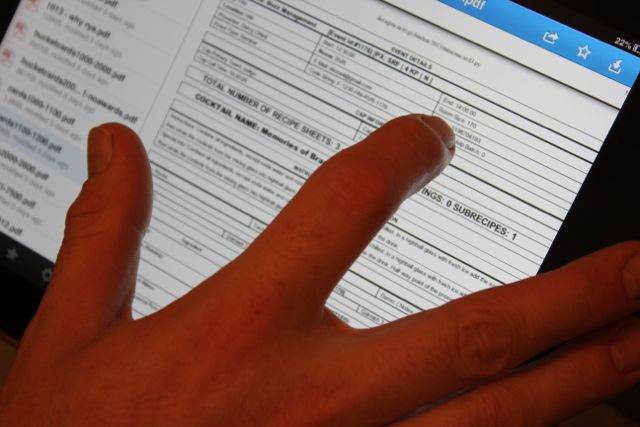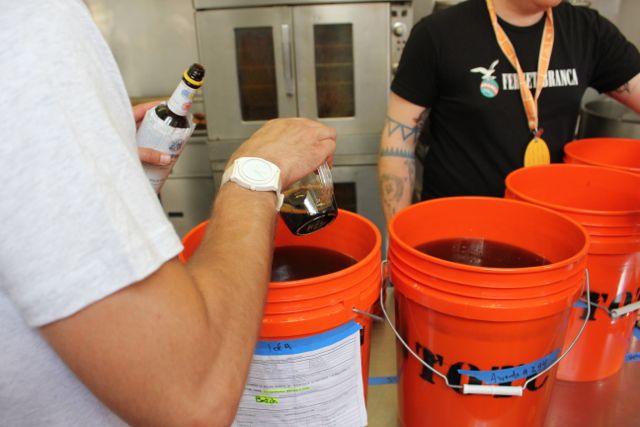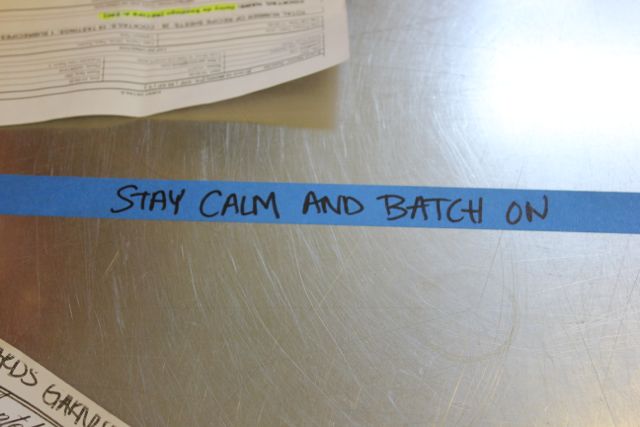How To Serve Cocktails To 23,000 Guests And Make It Look Easy
By Paul Leddy in Food on Mar 7, 2014 8:20PM

Bottles in a staging area ready to be pulled for batching cocktails.
During a five-day period last July, nearly 23,000 bartenders, liquor company professionals, distributors and cocktail aficionados descended upon New Orleans for the 11th Annual Tales of the Cocktail. While they came from different cities and backgrounds, they were all unified in one thing: they came very thirsty.
The numbers behind an event this size can be staggering: 274 total events, 6,496 bottles of liquor used, 15 tons of ice, 21,000 limes and 10,600 lemons squeezed. Fortunately, there is a group of people working behind the scenes, organizing and batching cocktails, to make sure it all goes smoothly.
The Tales of the Cocktail Apprentice Program (CAP) was established in 2008 as a way to handle the growing number of people who were attending the conference. While applications are accepted from a wide variety of backgrounds, working bartenders tend to express the most interest in joining the program. There is a multi-step application process that looks for well-rounded applicants that have the mettle to handle the pressure, pace, and physicality that the week brings.
We spoke to the Chicago representatives that were part of the apprentice program at Tales of the Cocktail last summer to get their thoughts on the program and see first-hand what a typical day is like.

A team prepares a cocktail for a seminar.
Expectations and Advice
For Jacyara de Oliveira, now a bartender at Sportsman’s Club, the program was viewed as a great learning opportunity. “I had never been to Tales before,” she explains. “I enjoy event production, logistical planning and problem solving and [thought the apprentice program] would help me gain that level of experience.”
Scofflaw bartender Uby Khawaja had experienced Tales of the Cocktail the year before and knew he wanted to do the apprentice program. “Tales is the epicenter of it all, and to be a part of making that happen is a huge deal,” Khawaja explains. “I really want to do more in the industry, and I [knew the] program would help.”
While both de Oliveira and Khawaja heard of the long hours and frequent consumption of the fruits of their labor, they still sought out the advice of former apprentices before they travelled to New Orleans.
“I went to Alex Renshaw (head bartender at drumBAR), who was an apprentice when I went down and Mike Ryan (CAP manager and head bartender at Sable), Khawaja said. “They said to keep eating and drink water. They recommended stocking up on Pedialyte and keeping snacks in the room. They said to stock up on clothes due to our days being long and sweaty.”
“[Before I went down for the first time as an apprentice in 2012,] I had heard horror stories. I was told by a lot of my peers that you are basically just a Tales of the Cocktail bitch that juices and sweats it out in the kitchen the whole week,” Renshaw recalls. “I figured since I was already doing that at work in Chicago, I might as well try to do it in New Orleans and get a vacation out of it.”
“My brother (Daniel de Oliveira, CAP class 2010 and Brand Ambassador for Olmeca Altos) prepared me for the longest of hours, the highest of temperatures, as well as the largest consumption rate of Mezcal I will ever see,” said de Oliveira, “His advice, along with the advice of many others, was to hydrate.”
At Tales ... or how people worked 12 hours a day and still found time to party
It all starts on Monday, when the apprentices and managers begin training, setting up the space, and plan out their week. Home base for the next 7 days is the Hotel Monteleone where most of the events and seminars take place. Other events are held down the street at the Hotel Sonesta.
The CAP program is split into 4 tiers: The Management Team, which includes Mike Ryan, wear white chef jackets; CAP Managers, which included Alex Renshaw, wear the grey jackets; returning CAP’s wear Black jackets and the new apprentices wear the red jackets. “Red because they are highly visible and are also expendable like in Star Trek,” jokes Ryan.

Ryan shows the worksheet that takes the initial, single-serving recipe and calculates for up to 1000 people.
Each seminar typically serves two to four cocktails chosen by the presenter. The presenter sends in their single-serving cocktail recipe to the team, who plug it into a spreadsheet that will calculate the quantities needed for groups that can range from 100-1,000. That data is populated on forms that give details such as event information, cocktail instructions, and number of people. This high-tech aspect is something that has been continually fine-tuned over the years. “We are finally starting to be able to blueprint this and say this is how you run an event the size of Tales,” explains Ryan. “The goal is to figure it out and then scale it down so we can produce events of any size pretty easily."
John Deragon, formerly from the New York bar, PDT (Please Don’t Tell) and part of the CAP Management Team, was there the first year of the apprentice program and he recounts with slight horror at the manual process. “The presenters didn't submit recipes,” Deragon says. “[They would] verbally confirm or email them; we had a lot of surprises with recipes. We had to hand calculate the day of at 6 a.m. and we were hand juicing everything (they use machines for most of their juicing now). We were working from 6 .a.m to 1 a.m. every day."
“We definitely impress upon the CAPS that it used to be very hard,” Ryan adds.
The real work for the apprentices begins on Wednesday when the events and seminars start. The apprentices are part of a three-person team is headed by a returning CAP and are responsible for the production of a seminar or events cocktails.
“A typical day had me waking up around 6:30, getting in the kitchen by 7 or 7:30,” Khawaja explains. ”You focus on what your group needs to accomplish. If you have “free” time, then you help another group.”
“My first Wednesday of prep I had time so I helped with the 4,000 lemon peels needed for a party. We also had our first seminar later that day at the Royal Sonesta. So I would help with the peels (in my case counting) and then focus on the seminar with my team.”
De Oliveira agrees, “A big part of the program was making yourself useful at any given moment. The second biggest part was knowing when to get out of the way.”
As a group leader, Renshaw saw opportunities for leadership training with his team. “As a team, we worked together on every event as either primary point team or a secondary team to lend a helping hand and follow the primary team's direction. I made it a goal to have each of my team members become a leader by the end of the week for one seminar each. They both performed flawlessly, I might add.”
With an event this size, there are bound to be moments where the fear that things were not going to meet the deadline. “My team never really got to the point where we didn’t think we were going to make it,” Khawaja recalls. “We definitely had moments when we were trying to find certain ingredients or trying to accommodate a presenter that made things interesting. You just keep going and make it happen, there were too many people relying on us.”
The days continued like this until 6 or 7 p.m., with a few opportunities to rest and recharge during the day. At 8pm, the team would regroup so the management team could debrief the team on the highs and lows of the day. There were also special seminars offered for the team.

For serving cocktails for a crowd this size, you don't use the dasher for Angostura bitters, you use a measuring cup.
The Closing Chapter to Tales
Now safely back in Chicago, the apprentices look back with fondness on their time in New Orleans. “The moments that stick out in my memory are of the sort that cannot be explained to those who didn't experience them in their original context,” explains de Oliveira. “[Those] brief moments that we as CAPs came together and were allowed to be ourselves. They were precious and hilarious and amazing. They were what bound us together in the end.”
“The apprentice program was one of the greatest experiences,” Khawaja adds. “The people you meet, the experience as a whole was amazing. It definitely exceeded expectations.”
De Oliveira feels that she learned more than how to manage large-scale events. “My love for the industry was reawakened,” she says. “I was reminded that hospitality, openness and community were the most important parts of being a bartender.”
If you think you have what it takes to be an apprentice for the premier cocktail event in the United States, applications are being accepted until April 1, 2014.
“People selected for the program range from “startending/barockstars” to brand new/up and coming bartenders in the industry,” Renshaw says. “My best advice is to set your ego aside and listen to how people, who have been there before, handle business. That and drink a lot of water, its fucking hot in New Orleans.”

Always remember to stay calm.